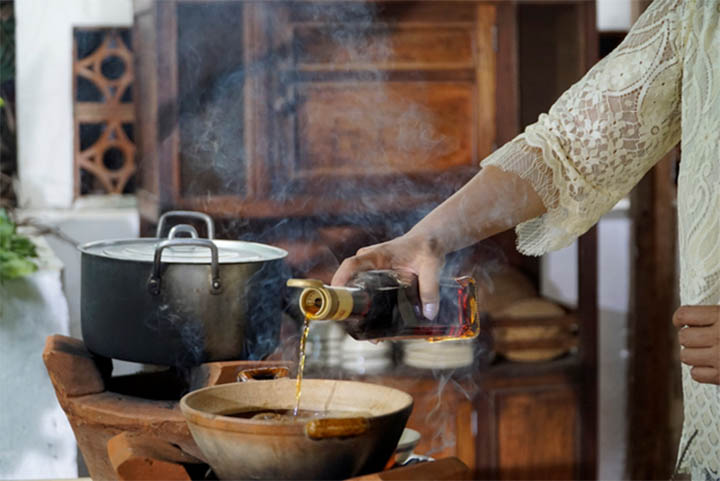
History of Vietnamese fish sauce
The history of Vietnamese fish sauce dates back hundreds of years, deeply intertwined with the coastal communities of Vietnam. Fishermen traditionally fermented fish with salt to preserve it for long journeys. Over time, this process evolved into a culinary art form, producing the rich, flavorful fish sauce we know today.
Each region in Vietnam has developed its own variations, with Phu Quoc and Nha Trang being among the most famous. The unique climate and local fish species contribute to the distinct flavors of these regional varieties.
Why does traditional Vietnamese fish sauce adhere to international standards?
In order to achieve strict standards, the process of producing traditional Vietnamese fish sauce is strictly controlled. From choosing the freshest ingredients to the traditional incubation process, each step is meticulously monitored. Only the most quintessential drops of fish sauce, rich in protein and typical aroma, are eligible for export and internationally recognized.
Premium ingredients are the key to creating a unique flavor of traditional Vietnamese fish sauce. Fresh anchovies, fishing in the peak crop, which is the foundation of the typical flavor. These anchovies are appreciated for their freshness and rich nutritional value. Pure sea salt also plays an important role, providing a characteristic salty taste to the final product.
Traditional incubation process, a long-standing technique, is another key factor. Anchovies and salt are classified in large wooden barrels and brewed in the sun for a long time. This natural processing process creates complex, rich flavor notes, typical for traditional Vietnamese fish sauce.
Quality and safety assurance meet international standards
International standards, such as HACCP and ISO 22000, serve as benchmarks for the quality and safety of Vietnamese traditional fish sauce. These certifications underscore the commitment of producers to delivering a safe and high-quality product.
Strict quality control protocols are observed during the entire production process. Every step, from obtaining raw materials to the last bottling, is put through rigorous testing. Customers can therefore feel secure in the knowledge that traditional Vietnamese fish sauce is free of dangerous ingredients. The TCVN 5107:2018 standard, the national standard for fish sauce in Vietnam, further reinforces the commitment to quality and food safety.
How to identify high-quality fish sauce
To choose the mainstream Vietnamese fish sauce, consumers need to pay attention to some important signs, helping to distinguish high-quality products from poor-quality products. Dark amber color is a sign of fish sauce that has been naturally incubated for enough time.
Product labels should only list two components: anchovy and salt, no artificial preservatives. High protein content (over 30N) is a high-end product index.
Not all fish sauces are the same. High-quality Vietnamese fish sauce is usually classified by nitrogen content, reflecting protein. Low-grade fish sauce is often diluted or mixed with additives to reduce costs, affecting flavor and authenticity. When choosing fish sauce, checking the content of nitrogen (N) is a good way to evaluate product quality
Health benefits of fish sauce
Vietnamese fish sauce, besides the typical flavor, also brings significant nutritional benefits to consumers. This product is a source of abundant protein and amino acids, playing an important role in building and maintaining muscle health, as well as supporting essential body functions.
An outstanding advantage of Vietnamese fish sauce is the natural production process, completely not using additives or artificial preservatives. This ensures safe and healthy products while maintaining traditional flavors.
In addition, fish sauce also helps to support metabolism and digestion. The natural enzymes in fish sauce can help decompose food and improve intestinal function, helping the body absorb nutrients more effectively.
With comprehensive nutritional benefits and unique flavors, Vietnamese fish sauce is not only an integral part of Vietnamese cuisine but also a healthy and nutritious choice for consumers around the world.
Versatility in culinary applications
The versatility of Vietnamese traditional fish sauce extends beyond its role as a dipping sauce. It's a culinary chameleon, used to season, marinate, and enhance a wide array of dishes. From stir-fries and soups to marinades and dressings, traditional Vietnamese fish sauce adds a distinctive depth of flavor.
Its adaptability has made it a favorite among chefs and home cooks alike. Vietnamese traditional fish sauce is not merely a condiment; it's a culinary ambassador of Vietnam. Each drop encapsulates the essence of the sea and the rich culinary heritage of the country.
Global culinary trends and the appeal of Vietnamese fish sauce
The global appeal of Vietnamese traditional fish sauce aligns with the growing trend towards natural and healthy foods. With its natural ingredients and unique flavor profile, Vietnamese traditional fish sauce is well-positioned to meet the demands of discerning consumers worldwide.
As Vietnamese traditional fish sauce gains international recognition, it's essential to preserve and promote its heritage. Supporting local producers and maintaining traditional production methods will ensure that this culinary treasure continues to delight palates for generations to come.
With its increasing popularity, Vietnamese fish sauce is now exported to major markets such as the US, Europe, and Japan. Many brands have successfully entered global markets by improving packaging, labeling, and certifications to meet import regulations.
Comparing Vietnamese fish sauce with other countries’ Variants
Vietnamese fish sauce is often compared to Thai, Filipino, and other Southeast Asian variants. While all share a common base of fermented fish, the differences in production methods, aging processes, and fish varieties used create distinct flavors.
Thai fish sauce tends to be slightly sweeter, while Filipino "patis" is often saltier. Vietnamese fish sauce is known for its balanced umami depth, making it a favorite among chefs worldwide.
Sustainability efforts of Vietnam fish sauce
To ensure Vietnamese fish sauce production stays sustainable, many producers are switching to eco-friendly fishing. Sustainable fishing techniques, such as using selective fishing and reducing fuel consumption not only protect the marine ecosystem but also ensure a high-quality and stable source of fish. This is especially important in the context of excessive fishing that is causing a serious imbalance for the marine ecosystem, affecting both the supply of raw materials and the habitats of marine species.
In addition, a number of brands are investing in recycled packaging and responsible supply methods, demonstrating increasing commitment to environmental conservation. The application of sustainable certificates such as MSC (marine management council) or ASC (aquaculture council) is also a testament to the commitment of manufacturers to international environmental standards, helping to enhance the reputation of Vietnam fish sauce products in the international market.
Consumers also play an important role in promoting the sustainability of the fish sauce manufacturing industry. By choosing products from manufacturers responsible for the environment, consumers can contribute to protecting the marine ecosystem and ensuring the source of premium fish sauce for future generations.
Choose traditional fish sauce at Vanpire
For the best quality, choose traditional Vietnamese fish sauce from Vanpire. Experience the authentic taste and superior quality that meets international standards!
You can find Vanpire’s high-quality fish sauce in select international markets, specialty US, EU, and Asian stores, and online. We ensure a seamless buying experience so that you can bring the taste of Vietnam into your kitchen.
Order today and experience the authentic flavor of traditional Vietnamese fish sauce at its finest!

